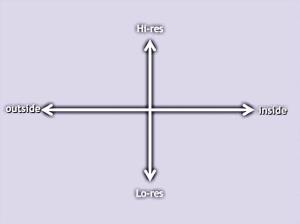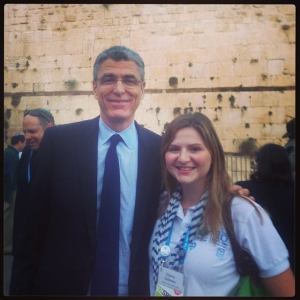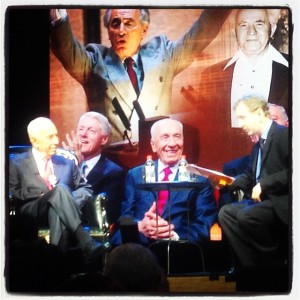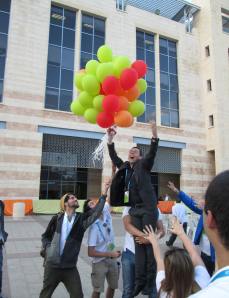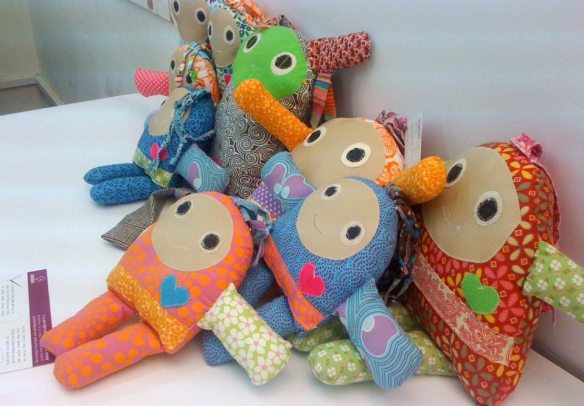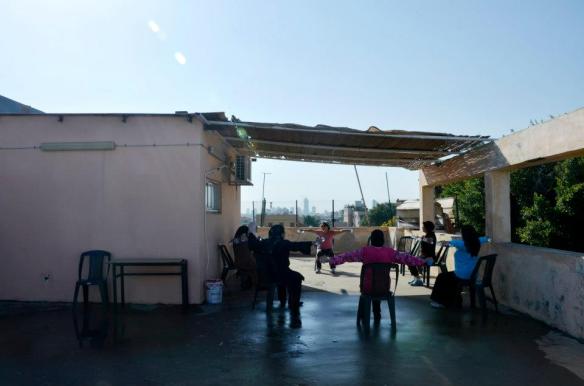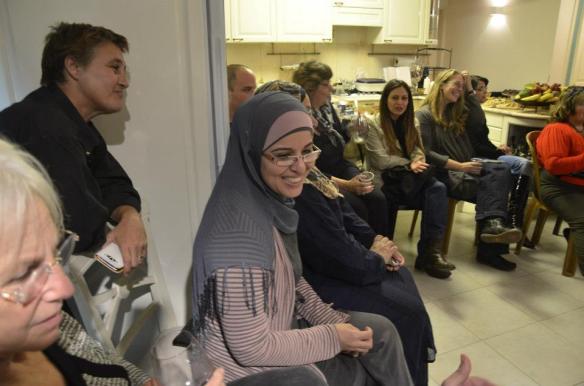Carrie was chosen to be part of the Masa delegation to the Jewish Federations of North America's General Assembly. Here, she writes about her experience at the conference.
I was lucky enough to be selected from the thousands of Masa participants, living and volunteering in Israel, to be one of 50 Masa delegates at The Jewish Federations of North America’s General Assembly[i]. This year’s GA[ii] was held in Jerusalem making it quite easy for the young leaders of tomorrow to attend. Below is a brief account my time in Jerusalem – November 7-12th.
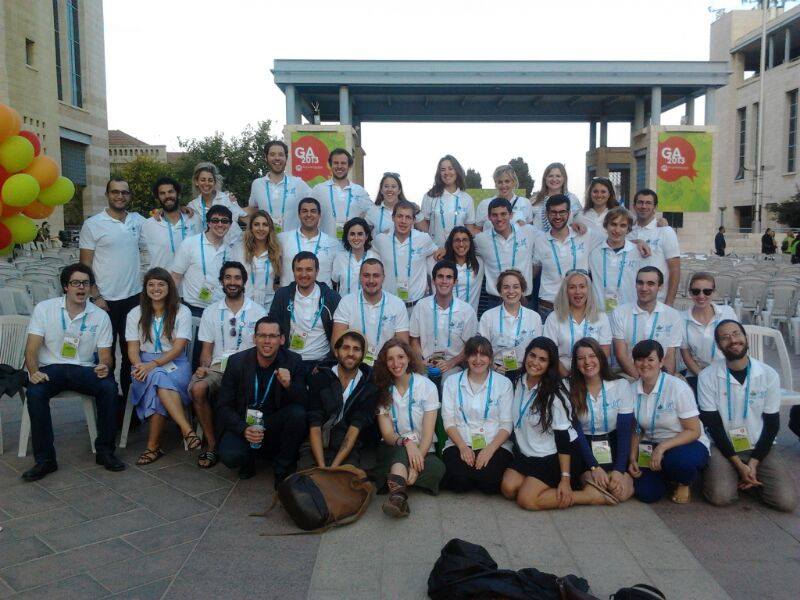
Masa Delegation - Carrie is in the last row, 3rd from right. Simi Adler, another Tikkun Olam participant, is in the last row, 2nd from left.
As I stepped off the bus in Jerusalem, as the sun was setting on November 7th I was unsure what to expect from the next five days. I knew little about Federations, having spent my Jewish life is very small communities, one which had a small Federation I had never engaged with (or had not engaged with me depending how one looks at it) and then in a town that was home to one congregation. Would it feel like I was drinking the cool-aid, so to speak, if I feel in love with this institution of Jewish outreach and engagement? Only time would tell…..
The first two days were dedicated primarily to preparing the Masa delegation for the events we would be attending during the GA. I was not the only representative that was not entirely sure what a federation was and what exactly they did. To be honest, I knew they were some kind of community Jewish group that fundraised (and did something else) aka they like people with money; I saw it as, I don’t have money so they aren’t overly interested in dealing with me. During our prep time, we were introduced to Jewish Agency & Federation leaders to try to better understand their organizations and for them to meet and hear from current Masa participants. We also heard from a few heads of Federations in America. It was interesting to learn more about what goes on with Federations ranging from small to the largest in America. Although most have to focus to some extend on fundraising, they also focus on programs to improving the lives of Israelis, education both in and outside of Israel, Jewish Identity, elderly care around the world and ultimately being a second home for Jews in the communities.
One of our prep sessions was led by Robbie Gringras from Makom, an initiative of the Jewish Agency for Israel, which trains leaders and creates educational content to embrace the vibrant complexity of Israel: The People and the Place. Robbie was highly engaging as he spoke to us about the Makom matrix and the ways Makom is looking to change how young diaspora Jews see Israel (side note- I believe the matrix works well for anyone to see where they are at & for educational leaders for all levels work to bring people to a high res-inside place.)
Because of this initial time with Robbie, one of my favorite events was the MAKOM Global Jewish Forum- Moving Israel Education held the morning before the Opening Plenary. We spent a great deal of time examining the Matrix in the Plenary, through viewing interviews of high school students who attended Jewish Day School in the US and Australia in which they were asked about how they saw their Jewish Identity and its connection to Israel.
Driven from multiple angles; including not only the changes within Israel in recent decades, changes in Jewish identity, and the rate of information exchange, think Facebook, Twitter, Instagram, Makom sees a need in for change to occur within Israel education. Makom is focusing on “reimagining the way we aim for our young people to relate to Israel.” Examining the Makom matrix with us beforehand, Robbie explained their most basic goal is to get people into the high-resolution/inside quadrant. Instead of seeing ones connection to Israel merely as outside (no affection for Israel) or inside (affection for Israel) they added the dimension of High resolution & Low resolution. Example –““Low-resolution” would suggest that green is green. “High-resolution” on the other hand, allows for green to break down into its component parts and become blue and yellow. And Hamas. And Environmental Issues. And Egged buses. And Maccabi Haifa soccer club. And and… The higher the resolution, the more knowledge, detail and nuance…” [iii] I know since my arrival in Israel and beginning Tikkun Olam, I have moved further into Hi-Res. Between my classes and day trips with Tikkun Olam, I have been gaining a better understanding of the complexity of Israel and her people. This way of looking at things really resounded with me and my goals for educating those around me and hopefully someday those in the congregation/federation/JCC/day school/Hillel that I work in.
The Grand Opening of the JFNA’s GA featured Israel’s current Prime Minter, Benjamin Netanyahu, and with that we were officially underway in our delegate responsibilities. The main events on Monday included an option to select from 20+ sessions held at three different times. I attended the following sessions; Crowdsourcing and Crowdfunding: Harnessing the Power of the People, 1967 versus 2013: How to Effectively Speak Out for Israel in a Changing World and Many Shades of Black: Insights into the Haredi World. My goal was to get out of my comfort zone and attend sessions I wasn’t automatically drawn to, i.e. about issues I already knew a good amount about. I have to say, I think I accomplished this. The next day was a fast paced, first visiting Hebrew Union College and then onto visiting a school with students enrolled in The Azrieli Institute for Educational Empowerment. We were then bused to the final event of the GA.
At the closing celebration, in Jerusalem’s Safra Square, we heard from Naftali Bennett, Natan Sharansky and Nir Barkat. Most in attendance then walked through Jerusalem’s Old City, in Jewish Unity to the Kotel. The most moving part was walking down to Azart Yisrael, the temporary egalitarian section of the Kotel. Azart Yisrael is a bridge to a permanent solution to ensure all Jews can pray at the wall in a way that is meaningful to them. It was an amazing experience to pray here. I was lucky enough to run into Rabbi Rick Jacobs, President of the Union for Reform Judaism, standing in the section. By the end of day five I was relatively exhausted but going from dawn to dusk (usually much later) will do that to most young people.
Overall highlights included a scavenger hunt through the shuk with representatives from the Jewish Agency for Israel as well as some leaders of Federations from the US, seeing and hearing from; a Prime Minister, a President, an Israeli party leader, a leading Haredi journalist, a mayor, a US Ambassador, young leaders in the crowd sourcing & funding world as well as multiple EVPs and CEOs of North American Federations. It was also amazingly delightful to connect with other ‘High-Res’ Masa participants from around the world, with different ways of expressing their Judaism, now living in vastly different places in Israel. I learned much about Federations and about myself and how I can continue on my Jewish journey. I know that no matter where I end up, from Federation to Temple, JCC to Hillel, this GA will impact the work I do.
Final Note: Now I would not want anyone reading this to think no one at the GA spoke or expressed concerned about the Pew Study. To be frank I heard more hashing and rehashing of the Pew study then I care to share. The interesting thing is I don’t actually think we (the larger Jewish community as a whole) honestly learned anything we didn’t already know from Pew. I didn’t feel my time would be best focused on Pew and as I mentioned early I was attending session that would push me.
[i] The JFNA in its own words:
The Jewish Federations of North America represents 153 Jewish Federations and over 300 Network communities, which raise and distribute more than $3 billion annually for social welfare, social services and educational needs. The Federation movement, collectively among the top 10 charities on the continent, protects and enhances the well-being of Jews worldwide through the values of tikkun olam (repairing the world), tzedakah (charity and social justice) and Torah (Jewish learning). http://www.jewishfederations.org/about-us.aspx
[ii] The JFNA’s explanation of the GA:
The General Assembly (GA) is the premier annual North American Jewish conference, attracting Federation lay leaders and professionals as well as the leadership of The Jewish Federation of North America’s partner organizations and other important national Jewish organizations. It’s an event that inspires and engages current and emerging Jewish leaders, tackles the most critical issues of the day, and showcases the best of the Federation movement. The GA plenaries, forums and workshops feature top speakers from the political, business and non-profit realms. http://www.jewishfederations.org/about-us.aspx

